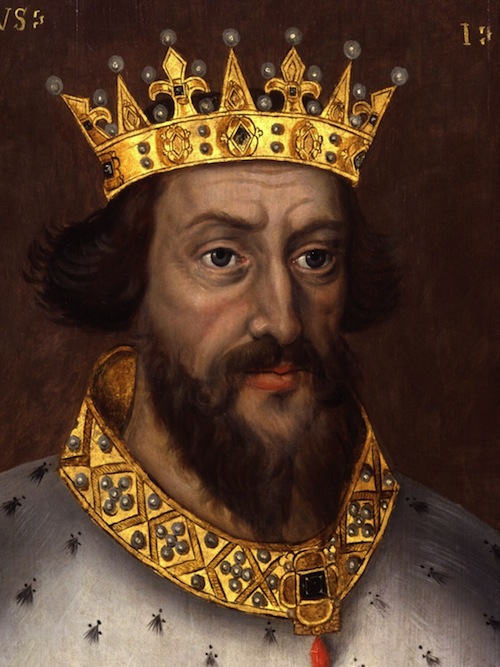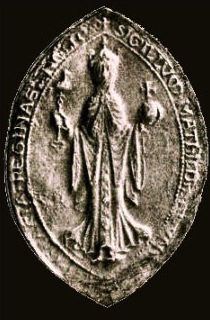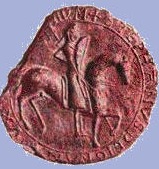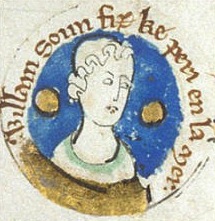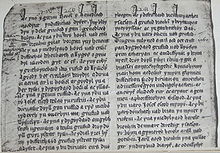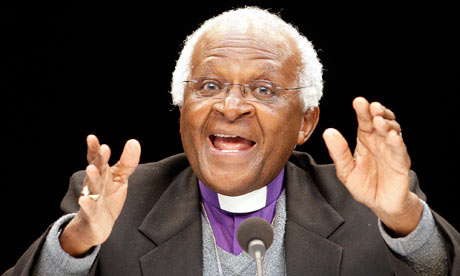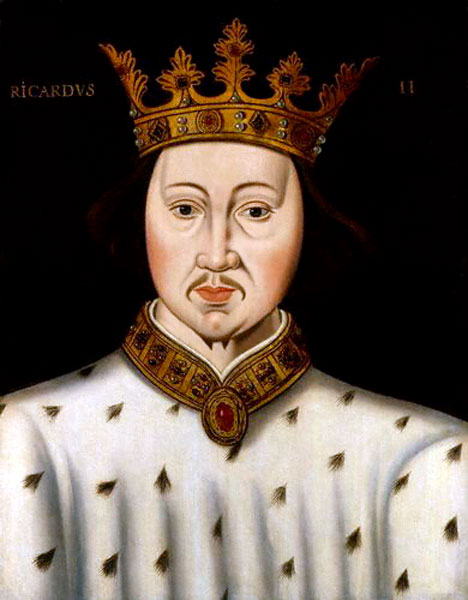Name: King Henry I
Born: September, 1068 at Selby, Yorkshire
Parents: William I and Matilda of Flanders
Relation to Elizabeth II: 24th great-grandfather
House of: Normandy
Ascended to the throne: August 3, 1100 aged 31 years
Crowned: August 6, 1100 at Westminster Abbey
Married: (1) Edith (Matilda), Daughter of Malcolm III
(2) Adelicia, Daughter of Geoffrey VII, count of Louvain
Children: Daughter Matilda, son William, and reputedly around 20 illegitimate children
Died: December 2, 1135 at St Denis le Fermont, Normandy, aged 67 years, 2 months, and 29 days
Buried at: Reading
Reigned for: 35 years, 3 months, and 28 days
Succeeded by: his nephew Stephen
Henry I (c. 1068 – 1 December 1135), also known as Henry Beauclerc, was King of England from 1100 to 1135. Henry was the fourth son of William the Conqueror and was educated in Latin and the liberal arts. On William’s death in 1087, Henry’s older brothers William Rufus and Robert Curthose inherited England and Normandy respectively, but Henry was left landless. Henry purchased the County of Cotentin in western Normandy from Robert, but was deposed by William and Robert in 1091. Henry gradually rebuilt his power base in the Cotentin and allied himself with William against Robert. Henry was on hand when William died in a hunting accident in 1100, and he seized the English throne, promising at his coronation to correct many of William’s less popular policies. Henry married Matilda of Scotland, but continued to have a large number of mistresses, by whom he had many illegitimate children.
Life
King of England from 1100. Youngest son of William the Conqueror, he succeeded his brother William II. He won the support of the Saxons by granting them a charter and marrying a Saxon princess, Edith, daughter of Malcolm III of Scotland. She was known as Matilda after her marriage, a name more acceptable to the Norman Barons than her Saxon name Edith. Henry’s daughter was also called Matilda. He was an able administrator, and established a professional bureaucracy and a system of travelling judges. He was called Beauclerc because of his scholarly interests.
In 1101 his elder brother Robert, Duke of Normandy, attempted to seize the crown by invading England. However, after the Treaty of Alton, Robert agreed to recognise his brother Henry as King and returned to Normandy. They fought again in 1106 at Battle of Tinchebrai at which Robert was captured and Henry became Duke of Normandy as well as King of England. Henry’s only legitimate son and heir, William, was drowned in 1120 in wreck of the White Ship and Henry tried to settle the succession on his daughter Matilda and her son Henry (later Henry II). However, Matilda widow of Henry V, Holy Roman Emperor, was unpopular when she re-married into the House of Anjou rival of the House of Normandy. The throne was taken by Henry’s nephew Stephen, who, towards the end of his reign, agreed to adopt Matilda’s son as his heir.
Henry died in Normandy in 1135 of food poisoning according to legend from eating a ‘surfeit of Lampreys’ (an eel type fish).
Henry I was the fourth son of William the Conqueror and Matilda of Flanders and was born between May, 1068 and May, 1069 probably at Selby in Yorkshire. He was named Henry after his mother’s maternal uncle, King Henry I of France. On the death of his father, Normandy was bequeathed to his eldest son, Robert Curthose , England was left to the third son, William Rufus (a second son, Richard, had been killed whilst hunting in the New Forest) and to the youngest, Henry, he left a large sum of money.
Henry I of England
Henry seized England’s crown on the death of his brother, William Rufus. He had been present on the hunting expedition in the New Forest which resulted in Rufus’ death, either by accident or design and left abruptly and in indecent haste to seize the treasury at Winchester. The finger of suspicion has been pointed at Henry of complicity in his brother’s death, Rufus was at the time refusing to sanction Henry’s plans to marry the (half Saxon) Scottish Princess Edith.
Henry I was crowned at Westminster on 1st August, 1100 and granted a popular coronation charter, promising to reform the abuses of his brother’s reign. He imprisoned the despised Ranulf Flambard, Rufus’ chief justiciar, thereby evoking the popular support of the English people.
Appearance and Character
Unlike Rufus, Henry had been born in England, which endeared him to the Saxon people. The historian William of Malmesbury leaves us with a contemporary description:-
‘He was of middle stature, his hair was black, but scanty near the forehead; his eyes were mildly bright, his chest brawny, his body well fleshed. He was facetious in proper season, nor did multiplicity of business cause him to be less pleasant when he mixed in society. Not prone to personal combat, he verified the saying of Scipio Africanus, ‘My mother bore me a commander not a soldier;’ wherefore he was inferior in wisdom to no king of modern time; and I may also say, he clearly surpassed all his predecessors in England and preferred contending by counsel, rather than by the sword. If he could he conquered without bloodshed; if it was unavoidable, with as little as possible.’
Henry was well educated and able to read and write in English and Latin, from which was coined his nick-name ‘Beauclerc, which was bestowed on him in the fourteenth century.
Marriage to Edith of Scotland
Henry further cemented his popularity, particularly among the Saxons, by marrying Edith of Scotland, the daughter of Malcolm Canmore, King of Scots and the Saxon St. Margaret (the sister of Edgar Atheling, of the Saxon Royal House) Edith, or Matilda, as she came to be known after her marriage, proved to be a good and much respected Queen.
Following the example of her saintly mother, Edith devoted herself to good causes, and often washed the feet of the poor. Though Henry was seldom faithful to his Queen, their’s was generally considered a good and happy marriage by Royal standards and helped to unite the rival claims of the Norman and Saxon Houses. Henry invited the much respected Anselm to return to England, a popular move, he had obviously learned from the mistakes of Rufus and was determined not to repeat them.
Henry I proved to be a serial adulterer and begat more illegitimate children than any other English King , in all he fathered twenty bastards, by a continuous string of mistresses. One of these was the beautiful Nesta, Princess of Wales, who became the mother of the King’s son, Henry. By far the most famous of Henry’s illegitimate offspring was Robert of Caen, later created Earl of Gloucester, he was born in 1090, by a Norman mother, before Henry came to the English throne and was later to play a leading part on the stage of English history. Sybil, his daughter by Sybil Corbet, who was born in the 1090’s was married to Alexander ‘the Fierce’, King of Scots, the brother of Henry’s Queen, Edith.
The Conquest of Normandy
Ranulf Flambard, imprisoned in the Tower of London, affected a daring escape and joined Robert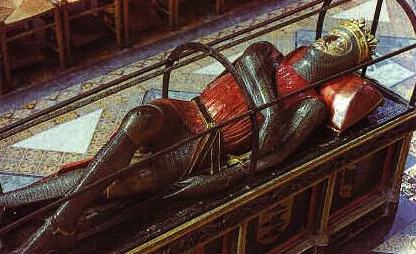 Curthose in Normandy in 1101. Robert, being the elder brother, considered England to be his just inheritance and war broke out over the issue. Robert invaded England on his return from the First Crusade, but agreement was finally reached between them whereby Robert renounced his claims to England in return for Henry’s Norman lands and a pension.
Curthose in Normandy in 1101. Robert, being the elder brother, considered England to be his just inheritance and war broke out over the issue. Robert invaded England on his return from the First Crusade, but agreement was finally reached between them whereby Robert renounced his claims to England in return for Henry’s Norman lands and a pension.
Henry later led an English army into Normandy which he took from his feckless brother at the Battle of Tinchebrai in 1106. The Saxons felt that fifty years later, the humiliation of Hastings had been truly avenged. Robert was held prisoner by his brother for the rest of his life and died in captivity at the age of eighty.
Henry I destroyed the power of the tyrannical Robert of Belleme. He set up a regular system of administration, ably aided by his minister Roger of Salisbury, who commended himself to the King by the speed he could get through mass. Henry clashed with Anselm over the rights of the church but eventually came to an agreement with him.
The Tragedy of the White Ship
Although he had many illegitimate children, Henry had only three children by his wife, Edith. Two sons, William, known as the Atheling, for his descent from the ancient Saxon Royal House and Richard. His daughter Matilda, or Maud, had been married in political alliance to the Holy Roman Emperor, Henry V, in childhood. She had spent most of her life in Germany. Richard pre-deceased his father.
Tragedy struck when Henry’s only remaining legitimate son, William, on returning from campaign in Normandy, was drowned in the English Channel in the wreck of the White Ship. William had got away in a lifeboat but went back for his illegitimate sister, the Countess of Perche, when his boat was overturned. Henry was overcome with immense grief.
In the hope of begetting another male heir to secure the succession, the King married for a second time to the young and beautiful Adelicia of Louvain, but the marriage produced no issue. After the death of her husband the Emperor, he recalled his daughter, by now known as the Empress, to England. He named her as his heiress and made the barons swear fealty to her.
The proud and haughty Matilda was ordered reluctantly into a marriage with the fifteen year old Geoffrey Plantagenet, son of the Count of Anjou, whom she personally loathed, a dislike which was reciprocated in full measure by her intended spouse. The marriage made an ally of Henry’s erstwhile enemy, Fulk of Anjou. When the reluctant and quarrelsome pair were finally ordered by Henry I to do their duty and produce an heir to his throne, a son, the future Henry II, was born. Henry rejoiced that his dynasty was now secure and crossed to Normandy to see his new grandson, namesake and heir. The old king was said to have doted on the child.
The Death of Henry I
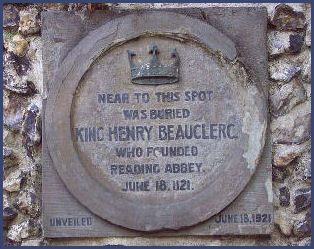 In 1135, Henry again crossed to Normandy to see his two grandsons, Henry and his younger brother, Geoffrey, in whom the ageing king took great delight, dandling the young Henry on his knee.
In 1135, Henry again crossed to Normandy to see his two grandsons, Henry and his younger brother, Geoffrey, in whom the ageing king took great delight, dandling the young Henry on his knee.
During his visit, he quarreled violently with the overbearing Matilda and her husband. Henry was now an ageing lion, these quarrels with his daughter affected him badly and he died in Normandy on 1st December, 1135 at St. Denis le Fermont, from food poisoning, due to over indulging of his favourite dish of lampreys, which his doctors had forbidden him.
His body was returned to England and was buried at Reading Abbey. The Abbey was destroyed during the Reformation. No trace of Henry’s tomb has survived. Nearby a small plaque and a large memorial cross has been erected in the adjoining Forbury Gardens.
After Henry’s death, despite his oath of alliegiance, the throne was seized by his nephew Stephen. Nineteen years of Civil War were to follow as Stephen and Matilda became locked in a bitter struggle for possession of the crown. In in 1153, a compromise was reached in the Treaty of Wallingford. By its terms, Stephen was to retain the crown for the remainder of his lifetime, whereupon it would revert to Matilda’s son, Henry and his heirs.
King Stephen died of an apoplexy, the following year and was succeeded by Henry’s grandson, Henry II, who became the the first of the great Plantagenet dynasty.
The Ancestry of Henry I
| Henry I | Father: William I ‘the Conqueror | Paternal Grandfather: Robert the Devil Duke of Normandy | Paternal Great-grandfather: Richard II, Duke of Normandy |
| Paternal Great-grandmother: Judith of Brittany | |||
| Paternal Grandmother: Herleva of Falaise | Paternal Great-grandfather: Fulbert, Tanner of Falaise | ||
| Paternal Great-grandmother: | |||
| Mother: Matilda of Flanders | Maternal Grandfather: Baldwin V, Count of Flanders | Maternal Great-grandfather: King Edmund II Ironside | |
| Maternal Great-grandmother: Edith | |||
| Maternal Grandmother: Adela of France | Maternal Great-grandfather: Baldwin IV, Count of Flanders | ||
| Maternal Great-grandmother: Ogive of Luxembourg |
The Children of Henry I
(1) Euphemia (July/August 1101 – died young).
(2) Matilda of England (c. February 1102 – 10 September 1167) married (1) Henry V, Holy Roman Emperor (2) Geoffrey V, ‘Plantagenet’ Count of Anjou
Issue by (2);-
(i) KING HENRY II
(ii) Geoffrey, Count of Nantes
(iii) William X, Count of Poitou
(3) William the Atheling, (5 August 1103 – 25 November 1120) married Matilda (d.1154), daughter of Fulk V, Count of Anjou.
(4) Elizabeth {August/September 1104) – Died young
Although he had four children by his wife, Edith of Scotland, Henry I had more illegitimate children than any other British monarch, numbering twenty-four in all:-
(1) Robert of Caen, Earl of Gloucestercirca 1090-1147
(2) Sybil circa 1090-1122 m. Alexander I of Scotland, daughter of Sybil Corbet
(3) Reginald de Dunstanville, Earl of Cornwall c.1103-1175 son of Sybil Corbet
(4) William b. circa 1105 possibly the son of Sybil Corbet
(5) Rohese m. Henry de la Pomerai, possibly the daughter of Sybil Corbet
(6) Gundred possibly the daughter of Sybil Corbet
(7) Robert, d. 1172 son of Edith of Greystoke
(8) Richard c.1099-1120 son of Ansfride
(9) Juliane b. circa 1090 m. Eustace de Pacy, daughter of Ansfride
(10) Maud d.1120 m. Rotrou, Count of Perche, daughter of Edith, she drowned in the White ship.
(11) Maud m. Conan III, Duke of Brittany
(12) Alice m. Matthew de Montmoremci, Constable of France
(13) Constance m. Roscelin de Beaumont, Viscount of Maine
(14) Maud, Abbess of Montvilliers
(15) Isabel b. circa 1120 daughter of Isabel of Meulan
(16) Fulk, possibly son of Ansfride
(17) Gilbert b. circa 1130
(18) William de Tracy d. circa 1140
(19) Henry c. 1105-1157 son of Nesta, Princess of South Wales
(20) Sybil of Falaise m. Baldwin de Boullers
Henry had at least another three illegitimate daughters whose names have gone unrecorded.
Death and legacy
Death, 1135
Relations between Henry, Matilda and Geoffrey became increasingly strained in the last few years of the King’s life. Matilda and Geoffrey suspected that they lacked genuine support in England, and proposed to Henry in 1135 that the king should hand over the royal castles in Normandy to Matilda whilst he was still alive and insist on the Norman nobility swearing immediate allegiance to her, thereby giving the couple a much more powerful position after Henry’s death. Henry angrily declined to do so, probably out of a concern that Geoffrey would try to seize power in Normandy. A fresh rebellion broke out amongst the barons in southern Normandy, led by William, the Count of Ponthieu, whereupon Geoffrey and Matilda intervened in support of the rebels.
Henry campaigned throughout the autumn, strengthening the southern frontier, and then travelled to Lyons-la-Forêt in November to enjoy some hunting, still apparently well. There Henry fell ill — according to the chronicler Henry of Huntingdon, he ate an excessive number of lampreys against his physician’s advice — and his condition worsened over the course of a week.
Once the condition appeared terminal, Henry gave confession and summoned Archbishop Hugh of Amiens, who was joined by Robert of Gloucester and other members of the court. In accordance with custom, preparations were made to settle Henry’s outstanding debts and to revoke outstanding sentences of forfeiture. The King finally died on 1 December 1135. Henry’s corpse was taken to Rouen accompanied by the barons, where it was embalmed; his entrails were buried locally at Port-du-Salut Abbey, and the preserved body was taken onto England, where it was interned at Reading Abbey.
Despite Henry’s efforts, the succession was disputed. When news began to spread of the King’s death, Geoffrey and Matilda were in Anjou, supporting the rebels in their campaign against the royal army, which included a number of Matilda’s supporters such as Robert of Gloucester. Many of these barons had taken an oath to stay in Normandy until the late king was properly buried, which prevented them from returning to England. The Norman nobility discussed declaring Theobald of Blois king. Theobald’s younger brother Stephen of Blois, however, quickly crossed from Bolougne to England, accompanied by his military household. With the help of his brother, Henry of Blois, he seized power in England, being crowned king on 22 December. The Empress Matilda did not give up her claim to England and Normandy, leading to the prolonged civil war known as the Anarchy between 1135 and 1153.
Historiography
Historians of Henry have drawn on a range of sources, including the accounts of chroniclers; other documentary evidence, including early pipe rolls; and surviving buildings and architecture. The three main chroniclers to describe the events of Henry’s life were William of Malmesbury, Orderic Vitalis and Henry of Huntingdon, but each incorporated extensive social and moral commentary into their accounts, and borrowed a range of literary devices and stereotypical events from other popular works.[316] Other chroniclers include Eadmer, Hugh the Chanter, Abbot Suger and the authors of the Welsh Brut. Not all royal documents from the period have survived, but there are a number of royal acts, charters, writs and letters, along with some early financial records.[318] Some of these have since been discovered to be forgeries, and others had been subsequently amended or tampered with.
Late medieval historians seized on selected chroniclers’ accounts of Henry’s education, and gave him the title of Henry “Beauclerc”, an theme echoed in the analysis of Victorian and Edwardian historians such as Francis Palgrave and Henry Davis. The historian Charles David dismissed this argument in 1929, showing the more extreme claims for Henry’s education to be without foundation. Modern histories of Henry commenced with Richard Southern’s work in the early 1960s, followed by extensive research during the rest of the 20th century into a wide number of themes from his reign in England, and a much more limited number of studies of his rule in Normandy. Only two major, modern biographies of Henry have been produced, Warren Hollister’s posthumous volume in 2001, and Judith Green’s 2006 work.
Historians’ interpretation of Henry’s personality has altered over time. Earlier historians such as Austin Poole and Richard Southern considered Henry as a cruel, draconian ruler. More recent historians, such as Hollister and Green, view his implementation of justice much more sympathetically, particularly when set against the standards of the day, but even Green has noted that Henry was “in many respects highly unpleasant”, and Alan Cooper has observed that many contemporary chroniclers were probably too scared of the King to voice much criticism. Historians have also debated the extent to which Henry’s administrative reforms genuinely constituted an introduction of what Hollister and John Baldwin have termed systematic, “administrative kingship”, or whether his outlook remained fundamentally traditional.
| Timeline for King Henry I |
| 1100 | Henry I succeeds his brother, William II. |
| 1100 | Henry issues a Charter of Liberties, pledging good governance. |
| 1100 | Henry marries Edith known as Matilda, daughter of Malcolm III of Scotland. |
| 1101 | Robert of Normandy invades England in an attempt to wrest the English throne from his brother, Henry. After failing, he signs the Treaty of Alton, which confirms Henry as King of England and Robert as Duke of Normandy. |
| 1106 | War breaks out between Henry and Robert. Henry defeats Robert at the Battle of Tinchebrai, imprisons him in Cardiff Castle, and takes control of Normandy. |
| 1118 | Death of Henry’s wife Matilda. |
| 1120 | Henry’s son and heir, William, is drowned at sea when returning from Normandy in The White Ship which strikes a rock and sinks. Henry’s daughter, Matilda, becomes heir. |
| 1121 | Henry marries Adelicia of Louvain |
| 1126 | Henry persuades the barons to accept Matilda as his lawful successor to the throne. |
| 1128 | Matilda, Henry’s only surviving legitimate child, marries Geoffrey, Count of Anjou. |
| 1135 | Henry I dies in Rouen, France, as a result of food poisoning |
Credits
http://www.englishmonarchs.co.uk/
http://www.britroyals.com/
Wikipedia

